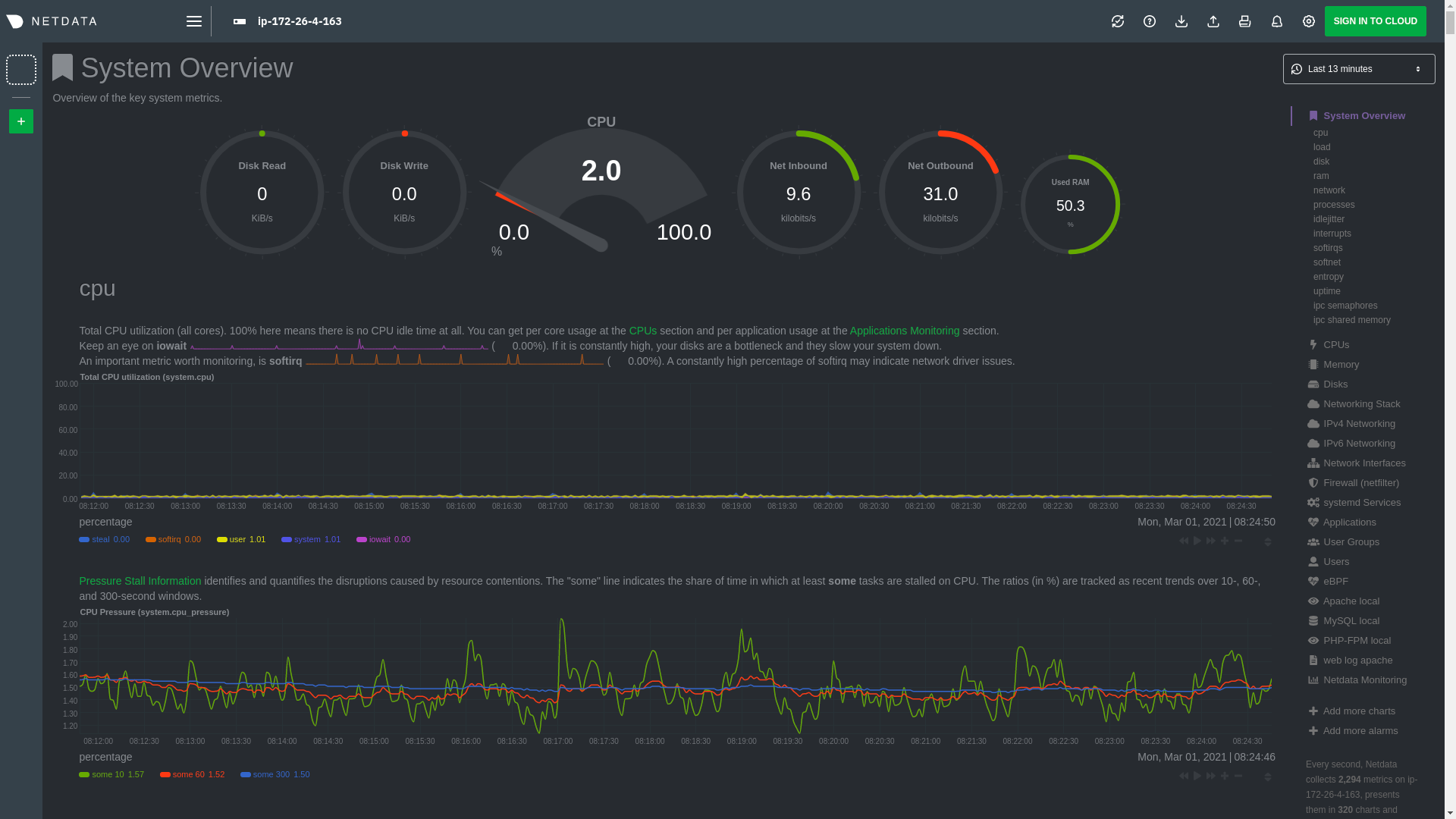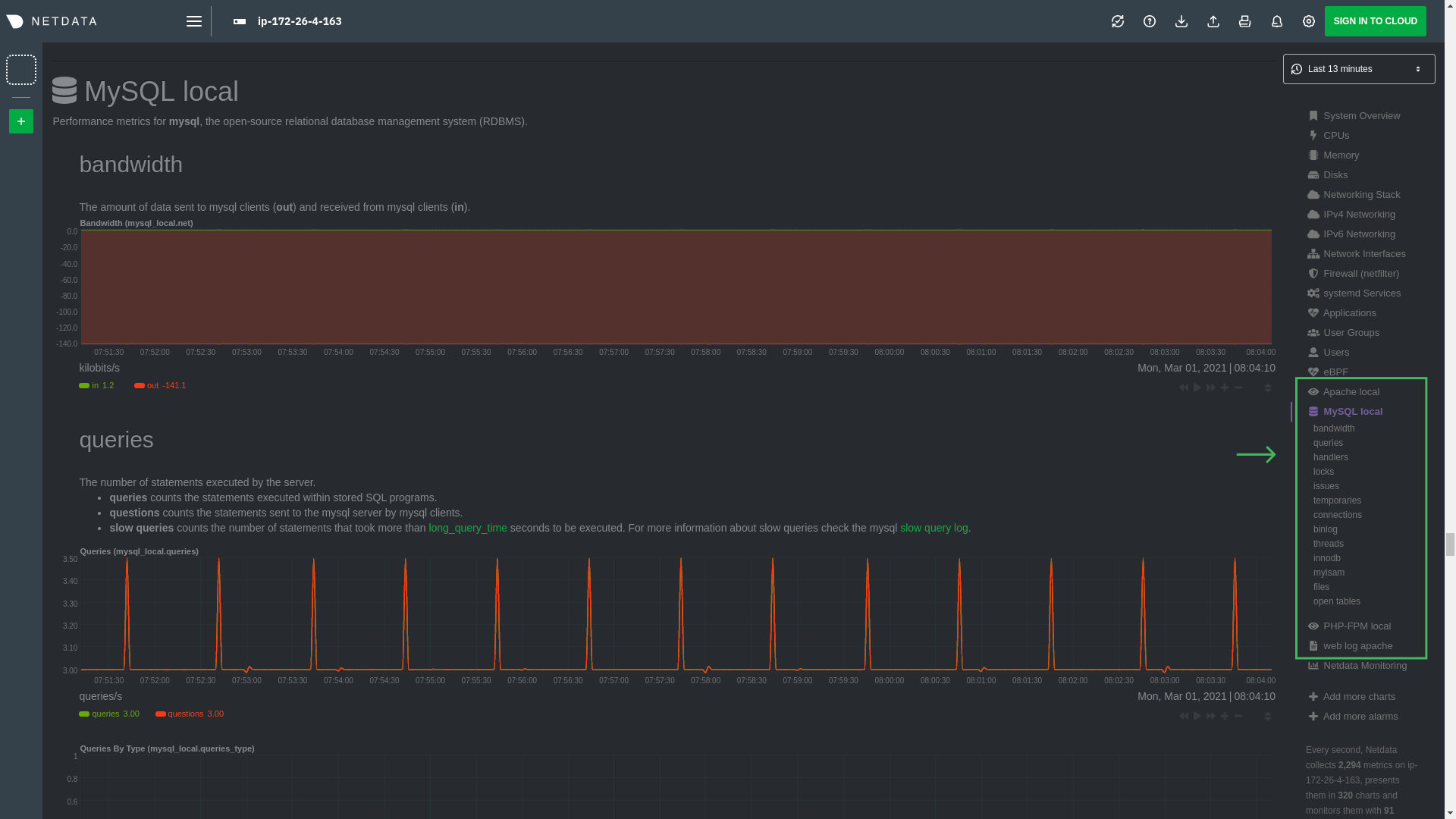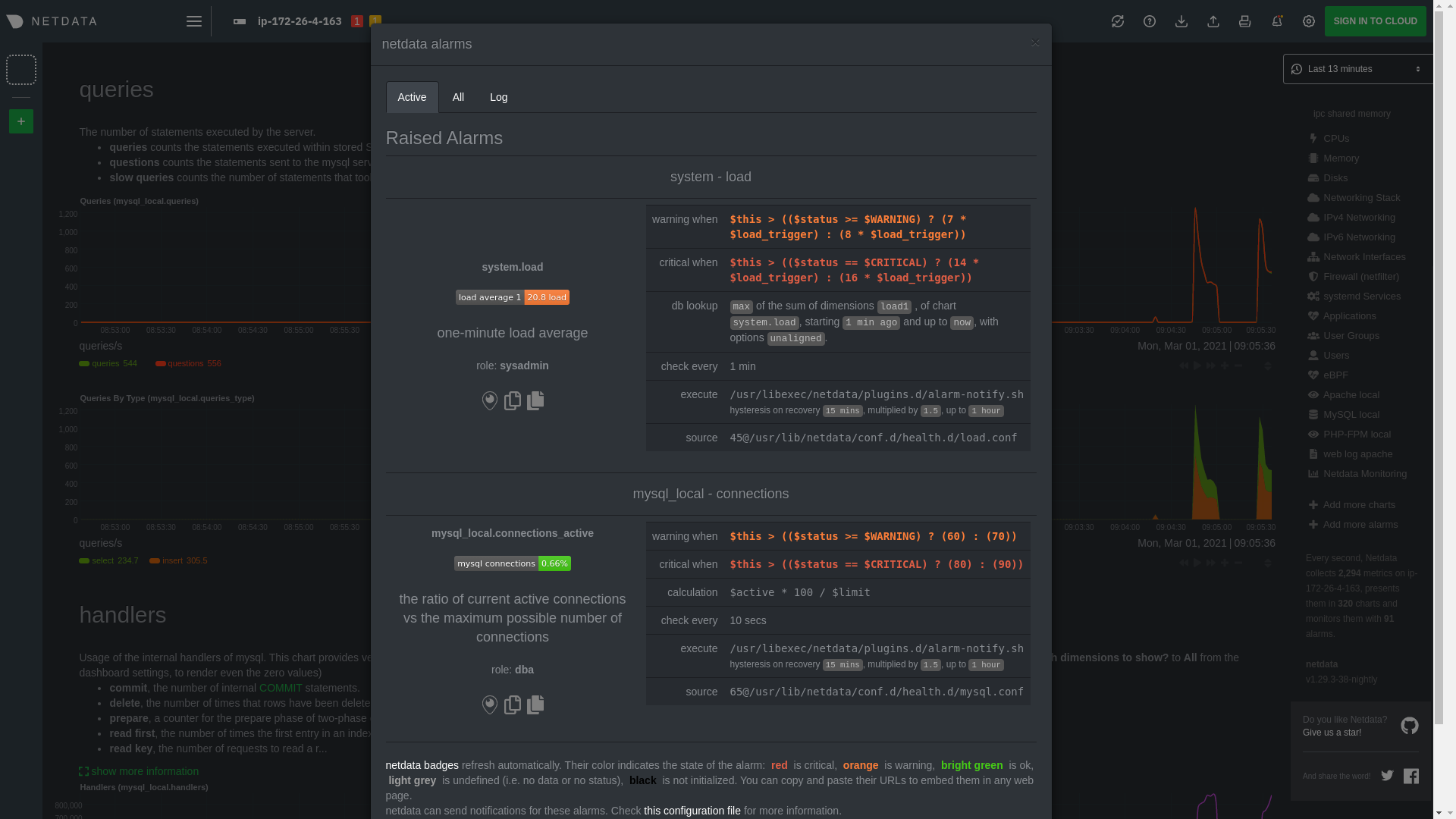1
2
3
4
5
6
7
8
9
10
11
12
13
14
15
16
17
18
19
20
21
22
23
24
25
26
27
28
29
30
31
32
33
34
35
36
37
38
39
40
41
42
43
44
45
46
47
48
49
50
51
52
53
54
55
56
57
58
59
60
61
62
63
64
65
66
67
68
69
70
71
72
73
74
75
76
77
78
79
80
81
82
83
84
85
86
87
88
89
90
91
92
93
94
95
96
97
98
99
100
101
102
103
104
105
106
107
108
109
110
111
112
113
114
115
116
117
118
119
120
121
122
123
124
125
126
127
128
129
130
131
132
133
134
135
136
137
138
139
140
141
142
143
144
145
146
147
148
149
150
151
152
153
154
155
156
157
158
159
160
161
162
163
164
165
166
167
168
169
170
171
172
173
174
175
176
177
178
179
180
181
182
183
184
185
186
187
188
189
190
191
192
193
194
195
196
197
198
199
200
201
202
203
204
205
206
207
208
209
210
211
212
213
214
215
216
217
218
219
220
221
222
223
224
225
226
227
228
229
230
231
232
233
234
235
236
237
238
239
240
241
242
243
244
245
246
247
248
|
<!--
title: "LAMP stack monitoring (Linux, Apache, MySQL, PHP) with Netdata"
description: "Set up robust LAMP stack monitoring (Linux, Apache, MySQL, PHP) in just a few minutes using a free, open-source monitoring tool that collects metrics every second."
image: /img/seo/guides/monitor/lamp-stack.png
author: "Joel Hans"
author_title: "Editorial Director, Technical & Educational Resources"
author_img: "/img/authors/joel-hans.jpg"
custom_edit_url: https://github.com/netdata/netdata/edit/master/docs/guides/monitor/lamp-stack.md
-->
# LAMP stack monitoring (Linux, Apache, MySQL, PHP) with Netdata
The LAMP stack is the "hello world" for deploying dynamic web applications. It's fast, flexible, and reliable, which
means a developer or sysadmin won't go far in their career without interacting with the stack and its services.
_LAMP_ is an acronym of the core services that make up the web application: **L**inux, **A**pache, **M**ySQL, and
**P**HP.
- [Linux](https://en.wikipedia.org/wiki/Linux) is the operating system running the whole stack.
- [Apache](https://httpd.apache.org/) is a web server that responds to HTTP requests from users and returns web pages.
- [MySQL](https://www.mysql.com/) is a database that stores and returns information based on queries from the web
application.
- [PHP](https://www.php.net/) is a scripting language used to query the MySQL database and build new pages.
LAMP stacks are the foundation for tons of end-user applications, with [Wordpress](https://wordpress.org/) being the
most popular.
## Challenge
You've already deployed a LAMP stack, either in testing or production. You want to monitor every service's performance
and availability to ensure the best possible experience for your end-users. You might also be particularly interested in
using a free, open-source monitoring tool.
Depending on your monitoring experience, you may not even know what metrics you're looking for, much less how to build
dashboards using a query language. You need a robust monitoring experience that has the metrics you need without a ton
of required setup.
## Solution
In this tutorial, you'll set up robust LAMP stack monitoring with Netdata in just a few minutes. When you're done,
you'll have one dashboard to monitor every part of your web application, including each essential LAMP stack service.
This dashboard updates every second with new metrics, and pairs those metrics up with preconfigured alarms to keep you
informed of any errors or odd behavior.
## What you need to get started
To follow this tutorial, you need:
- A physical or virtual Linux system, which we'll call a _node_.
- A functional LAMP stack. There's plenty of tutorials for installing a LAMP stack, like [this
one](https://www.digitalocean.com/community/tutorials/how-to-install-linux-apache-mysql-php-lamp-stack-ubuntu-18-04)
from Digital Ocean.
- Optionally, a [Netdata Cloud](https://app.netdata.cloud/sign-up?cloudRoute=/spaces) account, which you can use to view
metrics from multiple nodes in one dashboard, and a whole lot more, for free.
## Install the Netdata Agent
If you don't have the free, open-source Netdata monitoring agent installed on your node yet, get started with a [single
kickstart command](/docs/get-started.mdx):
```bash
bash <(curl -Ss https://my-netdata.io/kickstart.sh)
```
The Netdata Agent is now collecting metrics from your node every second. You don't need to jump into the dashboard yet,
but if you're curious, open your favorite browser and navigate to `http://localhost:19999` or `http://NODE:19999`,
replacing `NODE` with the hostname or IP address of your system.
## Enable hardware and Linux system monitoring
There's nothing you need to do to enable [system monitoring](/docs/collect/system-metrics.md) and Linux monitoring with
the Netdata Agent, which autodetects metrics from CPUs, memory, disks, networking devices, and Linux processes like
systemd without any configuration. If you're using containers, Netdata automatically collects resource utilization
metrics from each using the [cgroups data collector](/collectors/cgroups.plugin/README.md).
## Enable Apache monitoring
Let's begin by configuring Apache to work with Netdata's [Apache data
collector](https://learn.netdata.cloud/docs/agent/collectors/go.d.plugin/modules/apache).
Actually, there's nothing for you to do to enable Apache monitoring with Netdata.
Apache comes with `mod_status` enabled by default these days, and Netdata is smart enough to look for metrics at that
endpoint without you configuring it. Netdata is already collecting [`mod_status`
metrics](https://httpd.apache.org/docs/2.4/mod/mod_status.html), which is just _part_ of your web server monitoring.
## Enable web log monitoring
The Netdata Agent also comes with a [web log
collector](https://learn.netdata.cloud/docs/agent/collectors/go.d.plugin/modules/weblog), which reads Apache's access
log file, procesess each line, and converts them into per-second metrics. On Debian systems, it reads the file at
`/var/log/apache2/access.log`.
At installation, the Netdata Agent adds itself to the [`adm`
group](https://wiki.debian.org/SystemGroups#Groups_without_an_associated_user), which gives the `netdata` process the
right privileges to read Apache's log files. In other words, you don't need to do anything to enable Apache web log
monitoring.
## Enable MySQL monitoring
Because your MySQL database is password-protected, you do need to tell MySQL to allow the `netdata` user to connect to
without a password. Netdata's [MySQL data
collector](https://learn.netdata.cloud/docs/agent/collectors/go.d.plugin/modules/mysql) collects metrics in _read-only_
mode, without being able to alter or affect operations in any way.
First, log into the MySQL shell. Then, run the following three commands, one at a time:
```mysql
CREATE USER 'netdata'@'localhost';
GRANT USAGE, REPLICATION CLIENT, PROCESS ON *.* TO 'netdata'@'localhost';
FLUSH PRIVILEGES;
```
Run `sudo systemctl restart netdata`, or the [appropriate alternative for your
system](/docs/configure/start-stop-restart.md), to collect dozens of metrics every second for robust MySQL monitoring.
## Enable PHP monitoring
Unlike Apache or MySQL, PHP isn't a service that you can monitor directly, unless you instrument a PHP-based application
with [StatsD](/collectors/statsd.plugin/README.md).
However, if you use [PHP-FPM](https://php-fpm.org/) in your LAMP stack, you can monitor that process with our [PHP-FPM
data collector](https://learn.netdata.cloud/docs/agent/collectors/go.d.plugin/modules/phpfpm).
Open your PHP-FPM configuration for editing, replacing `7.4` with your version of PHP:
```bash
sudo nano /etc/php/7.4/fpm/pool.d/www.conf
```
> Not sure what version of PHP you're using? Run `php -v`.
Find the line that reads `;pm.status_path = /status` and remove the `;` so it looks like this:
```conf
pm.status_path = /status
```
Next, add a new `/status` endpoint to Apache. Open the Apache configuration file you're using for your LAMP stack.
```bash
sudo nano /etc/apache2/sites-available/your_lamp_stack.conf
```
Add the following to the end of the file, again replacing `7.4` with your version of PHP:
```apache
ProxyPass "/status" "unix:/run/php/php7.4-fpm.sock|fcgi://localhost"
```
Save and close the file. Finally, restart the PHP-FPM, Apache, and Netdata processes.
```bash
sudo systemctl restart php7.4-fpm.service
sudo systemctl restart apache2
sudo systemctl restart netdata
```
As the Netdata Agent starts up again, it automatically connects to the new `127.0.0.1/status` page and collects
per-second PHP-FPM metrics to get you started with PHP monitoring.
## View LAMP stack metrics
If the Netdata Agent isn't already open in your browser, open a new tab and navigate to `http://localhost:19999` or
`http://NODE:19999`, replacing `NODE` with the hostname or IP address of your system.
> If you [signed up](https://app.netdata.cloud/sign-up?cloudRoute=/spaces) for Netdata Cloud earlier, you can also view
> the exact same LAMP stack metrics there, plus additional features, like drag-and-drop custom dashboards. Be sure to
> [claim your node](/claim/README.md) to start streaming metrics to your browser through Netdata Cloud.
Netdata automatically organizes all metrics and charts onto a single page for easy navigation. Peek at gauges to see
overall system performance, then scroll down to see more. Click-and-drag with your mouse to pan _all_ charts back and
forth through different time intervals, or hold `SHIFT` and use the scrollwheel (or two-finger scroll) to zoom in and
out. Check out our doc on [interacting with charts](/docs/visualize/interact-dashboards-charts.md) for all the details.

The **System Overview** section, which you can also see in the right-hand menu, contains key hardware monitoring charts,
including CPU utilization, memory page faults, network monitoring, and much more. The **Applications** section shows you
exactly which Linux processes are using the most system resources.
Next, let's check out LAMP-specific metrics. You should see four relevant sections: **Apache local**, **MySQL local**,
**PHP-FPM local**, and **web log apache**. Click on any of these to see metrics from each service in your LAMP stack.

### Key LAMP stack monitoring charts
Here's a quick reference for what charts you might want to focus on after setting up Netdata.
| Chart name / context | Type | Why? |
|-------------------------------------------------------|---------------------|-----------------------------------------------------------------------------------------------------------------------------------------------------------------------------------------------------------------|
| System Load Average (`system.load`) | Hardware monitoring | A good baseline load average is `0.7`, while `1` (on a 1-core system, `2` on a 2-core system, and so on) means resources are "perfectly" utilized. Higher load indicates a bottleneck somewhere in your system. |
| System RAM (`system.ram`) | Hardware monitoring | Look at the `free` dimension. If that drops to `0`, your system will use swap memory and slow down. |
| Uptime (`apache_local.uptime`) | Apache monitoring | This chart should always be "climbing," indicating a continuous uptime. Investigate any drops back to `0`. |
| Requests By Type (`web_log_apache.requests_by_type`) | Apache monitoring | Check for increases in the `error` or `bad` dimensions, which could indicate users arriving at broken pages or PHP returning errors. |
| Queries (`mysql_local.queries`) | MySQL monitoring | Queries is the total number of queries (queries per second, QPS). Check this chart for sudden spikes or drops, which indicate either increases in traffic/demand or bottlenecks in hardware performance. |
| Active Connections (`mysql_local.connections_active`) | MySQL monitoring | If the `active` dimension nears the `limit`, your MySQL database will bottleneck responses. |
| Performance (phpfpm_local.performance) | PHP monitoring | The `slow requests` dimension lets you know if any requests exceed the configured `request_slowlog_timeout`. If so, users might be having a less-than-ideal experience. |
## Get alarms for LAMP stack errors
The Netdata Agent comes with hundreds of pre-configured alarms to help you keep tabs on your system, including 19 alarms
designed for smarter LAMP stack monitoring.
Click the 🔔 icon in the top navigation to [see active alarms](/docs/monitor/view-active-alarms.md). The **Active** tabs
shows any alarms currently triggered, while the **All** tab displays a list of _every_ pre-configured alarm. The

[Tweak alarms](/docs/monitor/configure-alarms.md) based on your infrastructure monitoring needs, and to see these alarms
in other places, like your inbox or a Slack channel, [enable a notification
method](/docs/monitor/enable-notifications.md).
## What's next?
You've now set up robust monitoring for your entire LAMP stack: Linux, Apache, MySQL, and PHP (-FPM, to be exact). These
metrics will help you keep tabs on the performance and availability of your web application and all its essential
services. The per-second metrics granularity means you have the most accurate information possible for troubleshooting
any LAMP-related issues.
Another powerful way to monitor the availability of a LAMP stack is the [`httpcheck`
collector](https://learn.netdata.cloud/docs/agent/collectors/go.d.plugin/modules/httpcheck), which pings a web server at
a regular interval and tells you whether if and how quickly it's responding. The `response_match` option also lets you
monitor when the web server's response isn't what you expect it to be, which might happen if PHP-FPM crashes, for
example.
The best way to use the `httpcheck` collector is from a separate node from the one running your LAMP stack, which is why
we're not covering it here, but it _does_ work in a single-node setup. Just don't expect it to tell you if your whole
node crashed.
If you're planning on managing more than one node, or want to take advantage of advanced features, like finding the
source of issues faster with [Metric Correlations](https://learn.netdata.cloud/docs/cloud/insights/metric-correlations),
[sign up](https://app.netdata.cloud/sign-up?cloudRoute=/spaces) for a free Netdata Cloud account.
### Related reference documentation
- [Netdata Agent · Get started](/docs/get-started.mdx)
- [Netdata Agent · Apache data collector](https://learn.netdata.cloud/docs/agent/collectors/go.d.plugin/modules/apache)
- [Netdata Agent · Web log collector](https://learn.netdata.cloud/docs/agent/collectors/go.d.plugin/modules/weblog)
- [Netdata Agent · MySQL data collector](https://learn.netdata.cloud/docs/agent/collectors/go.d.plugin/modules/mysql)
- [Netdata Agent · PHP-FPM data collector](https://learn.netdata.cloud/docs/agent/collectors/go.d.plugin/modules/phpfpm)
[](<>)
|
